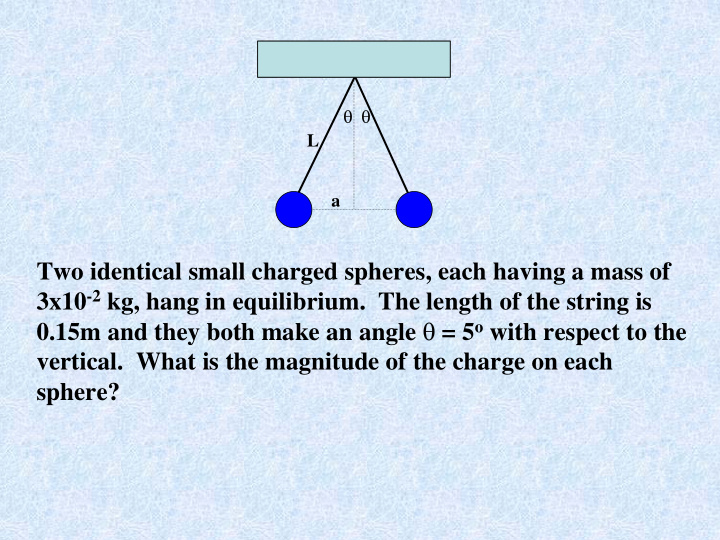



θ θ L a Two identical small charged spheres, each having a mass of 3x10 -2 kg, hang in equilibrium. The length of the string is 0.15m and they both make an angle θ = 5 o with respect to the vertical. What is the magnitude of the charge on each sphere?
0.30m 0.20m x -8 µ C 3 µ C -4 µ C What is the net electrostatic force on the 8 µ C charge due to the other two charges? y 65 µ C 0.6m 0.30m x 30 o 50 µ C -86 µ C 0.52m What is the net electrostatic force on the 65 µ C charge due to the other two charges?
y P 0.4m x q 1 q 2 0.3m A charge q 1 = 7 µ C is located on the x-axis and a charge q 2 = -5 µ C is located 0.3m from q 1 on the x-axis. What is the electric field at the point P with coordinates (0,0.4)m? If a 2 µ C chare were placed at point P, what is the net electrostatic force felt by the charge?
y r a P θ x x -a What is the electric field at a point P due to the electric dipole (two equal and opposite charges separated by a fixed distance) situated on the y-axis as shown? What is the electric field at a point P if x >> a?
v E L An electron enters a region of uniform electric field (E = 200 N/C) with a velocity of 3x10 6 m/s. What is the acceleration of the electron, the time it takes the electron to travel through the field and the vertical displacement of the electron while it is in the field? The length of the region L = 0.1m. How much work was done on the particle by the field?
Given the two charges shown below, at what position(s) x is the electric field zero? Is the field zero at any other points, not on the x axis? A proton (m p = 1.67x10 -27 kg) is suspended at rest in a uniform electric field Take into account gravity at the Earth’s surface, and determine
Recommend
More recommend